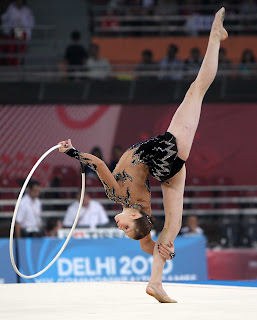 |
| Wales' Frankie Jones: TeamGB's soul individual rhythmic gymnast at London 2012 |
On 4 July Francesca Jones was officially announced as Team GB's sole individual representative for Rhythmic Gymnastics at the London 2012 Olympic Games.
Frankie, who is from Wellingborough in Northampton, surprisingly started training in Artistic Gymnastics when she was ten years old and then came to rhythmic aged 12.
“In the early days of coaching Frankie she was quiet, methodical and hard working. She was very receptive to improving and generally a lovely gymnast to coach," says Jo Coombs, Frankie’s Welsh Coach and mentor.
“Frankie was potential talent from the word go. She was very capable of doing the elements of a high degree of difficulty, which would show that she actually had the talent, as well as having a good range of movement and skill ability.
“I remember teaching Frankie a back flexion pirouette when she was younger - an element most gymnasts find nigh on impossible to learn - but Frankie had the natural capabiltities to get into that position.
“It has been those natural skills that have allowed her to progress onto more difficult skills,” adds Jo.
As a competitive discipline Rhythmic Gymnastics evolved toward the 1920s in the USSR. However it wasn’t until the late 1950s that it received the International Federation of Gymnastics (FIG) recognition. The individual competition premiered in Budapest in 1963 at the World Championships and Rhythmic Gymnastics was fully included in the Olympics in 1984 at the Los Angeles Games.
“Rhythmic Gymnastics is very watchable as a spectator sport," Jo explains. "It’s elegant; it incorporates the skills of an acrobat, the dexterity of a juggler and the beauty of a dancer. It maintains the feminine form and stays true to the flexibility elements associated with gymnastics,”
Rhythmic Gymnasts perform to music on a floor area measuring 13x13 metres and they use five pieces of hand apparatus rope, ball, hoop, clubs and ribbon but only four during a competition, (which four, is decided on a rotational basis before the competition begins). Apparatus must be handled with as much variety as possible and must be in constant motion. Routines include specific fundamental groups of body movements and technical groups that incorporate a variety of shape, amplitude, direction plane and speed along with apparatus usage.
The apparatus
The Rope is made of hemp, or other synthetic material, and is proportional to the gymnasts’ height. The fundamental groups of body movement for the rope include; jumps, leaps, skips and hops. The technical elements are jumps and skips. The rope is a very dynamic piece of apparatus requiring agility, jumping ability and co-ordination.
The Hoop is made of plastic or wood. The groups of body movement required for the hoop are; jumps, leaps, pivots, balance and flexibility. Technical groups are rolls over the body on the floor, rotations around the hand or other parts of the body throws and catches. Handling the apparatus includes swings, circle and figure of eights.
The Ball is the elegant piece of apparatus and is made of rubber. Technical groups of body movement include throws, catches, bouncing and rolling over the body or on the floor. Handling elements involved with the ball are ‘thrusts’, swings, circles, figure of eights and flip overs.
The Club are 40-50cm long and are made of wood or a synthetic material. The fundamental body movements for the clubs are balance elements. The technical groups of body movements include mills, small circles, throws, catches and tapping. Handling elements are ‘thrusts’, figure of eights and asymmetrical movements.
The Ribbon was first introduced in 1971 at the World Championships in Cuba. It is made of satin, measures six metres long and 4-6cm wide. The fundamental groups of body movement are pivots. The technical groups are; ‘snakes’, spirals, throws, catches and small tosses. Handling elements include; ‘thrusts’, swings, circles and figure of eights. Movements with the ribbon should be large and free flowing and require strength of shoulders and arm muscles.
“Children should give Rhythmic Gymnastics a try because it improves, like all forms of gymnastics, fundamental skills for life, which can transferable onto other sports and other ways of life. It’s a sociable sport which teaches children discipline and respect, plus it’s a whole lot of fun,” Jo continues.
“Having Frankie at the Olympics will help bring the discipline to life, in-terms of creating a wider exposure for Rhythmic Gymnastics, which will be great for which will be great for existing clubs offering Rhythmic Gymnastics. It also presents an opportunity for other gymnastic clubs to start up Rhythmic sections, which Welsh Gymnastics can help support.”
Currently you can try Rhythmic Gymnastics at Llanelli Gymnastic Club, Phoenix Gymnastic Club and Barry YMCA.
For more information visit Welsh Gymnastics and follow @GymnationWales on Twitter.
No comments:
Post a Comment